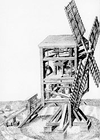| ENCYCLOP?DIA BRITANNICA | |||||
ανεμόμυλος windmill
Οπως οι νερόμυλοι έτσι και οι ανεμόμυλοι ήταν οι αρχικοί λόγοι έτσι ώστε οι άνθρωποι να μην χρησιμοποιούνται για παραγωγή ενέργειας. Η χρήση των ανεμόμυλων γρήγορα διαδόθηκε στην Ευρώπη από τον 12ο αιώνα μέχρι τις αρχές του 19ου. Η παρακμή τους από ατμομηχανές κράτησε άλλα 100 χρόνια. Η γρήγορη εξαφάνισή τους άχρισε από τον 1ο Παγκόσμιο Πόλεμο με την εξέλιξη του κινητήρα εσωτερικής καύσης και την διάδοση της ηλεκτρικής ενέργειας: από εκείνο το χρονικό διάστημα μελετήθηκαν τρόποι χρήσης της αιολικής ενέργειας στην παραγωγή της ηλεκτρικής. Like waterwheels, windmills were among the original prime movers that replaced human beings as a source of power. The use of windmills was increasingly widespread in Europe from the 12th century until the early 19th century. Their slow decline, because of the development of steam power, lasted for a further 100 years. Their rapid demise began following World War I with the development of the internal-combustion engine and the spread of electric power; from that time on, however, electrical generation by wind power has served as the subject of more and more experiments. Οι παλαιότερες γνώσεις μας για ύπαρξη ανεμόμυλων είναι για έναν Περσικό μύλο το 644 και για ανεμόμυλο το 915 στην Περσία. αυτοί ήταν από τους οριζόντιους με πανιά που στέκονταν σε κάθετους άξονες σε κτήριο που είχε είσοδο και έξοδο διαμετρικά αντίθετες μεταξύ τους. Κάθε ένας οδηγούσε ένα ζευγάρι πέτρες άμεσα χωρίς γρανάζια και ο σχεδιασμός τους ήταν παρμένος από τους νερόμυλους της εποχής. Οι περσικοί ανεμόμυλοι κατακτήθηκαν από τις δυνάμεις του Τζέκις Χαν και στάλθηκαν στην Κίνα για να βοηθήσουν να φτιαχτούν καινούργοι: η χρήση τους για άρδευση ήταν η τελευταία από τότε. The earliest-known references to windmills are to a Persian millwright in AD 644 and to windmills in Seistan, Persia, in AD 915. These windmills are of the horizontal-mill type, with sails radiating from a vertical axis standing in a fixed building, which has openings for the inlet and outlet of the wind diametrically opposite to each other. Each mill drives a single pair of stones directly, without the use of gears, and the design is derived from the earliest water mills. Persian millwrights, taken prisoner by the forces of Genghis Khan, were sent to China to instruct in the building of windmills; their use for irrigation there has lasted ever since. Ο κάθετος ανεμόμυλος με πανιά σε οριζόντιο άξονα, προέρχεται από τον Ρωμαϊκό νερόμυλο με τη χρήση ζευγαριού από γρανάζια. Η παλαιότερη μορφή κάθετου ανεμόμυλου είναι γνωστή σαν επιστήλιος ανεμόμυλος. Είχε σώμα σαν κουτί που περιλάμβανε τα γρανάζια, τις πέτρες, τα άλλα μηχανικά μέρη και κράταγε τα πανιά. Ήταν τοποθετημένος σε καλά υποστηριγμένο ξύλινο στήλο αρθρωμένος σε οριζόντια ακτίνα στο ύψος του δεύτερου ορόφου. Πάνω σε αυτό μπορούσε να περιστραφεί έτσι ώστε τα πανιά να βλέπουν προς τον άνεμο. The vertical windmill, with sails on a horizontal axis, derives directly from the Roman water mill with its right-angle drive to the stones through a single pair of gears. The earliest form of vertical mill is known as the post mill. It has a boxlike body containing the gearing, millstones, and machinery and carrying the sails. It is mounted on a well-supported wooden post socketed into a horizontal beam on the level of the second floor of the mill body. On this it can be turned so that the sails can be faced into the wind. Η επόμενη εξέλιξη ήταν να τοποθετούν τις πέτρες και τα γρανάζια σε σταθερό πύργο. Αυτός είχε κινούμενη κορυφή που περιλάμβανε τα πανιά που περιστρεφόταν στη κορυφή του πύργου. Η παλαιότερη κατασκευή ανεμόμυου πύργου χρονολογείται από το 1420. Και οι δυο μορφές βρίσκονται στην Ευρώπη και στην Αμερική από τους άποικους. The next development was to place the stones and gearing in a fixed tower. This has a movable top, or cap, which carries the sails and can be turned around on a track, or curb, on top of the tower. The earliest-known illustration of a tower mill is dated about 1420. Both post and tower mills were to be found throughout Europe and were also built by settlers in America. Η κυριότερη χρήση ανεμόμυλων άταν για να αλέθουν στάρι. Σε ορισμένες περιοχές οι χρήσεις του για αποξύρανση και άντληση ήταν εξίσου σημαντικές. Οι ανεμόμυλοι χρησιμοποιήθηκαν σαν πηγή ηλεκτρικής ενέγρειας με τον μύλο του P. La Cour, που κατασκευάστηκε στην Δανία το 1890 με διπλά πανιά σε ατσάλινο πύργο. Το ενδιαφέρον του κόσμου για τους ανεμόμυλους σαν μετατροπείς ενέργειας ξανάρχισε το 1970. The most important use of the windmill was for grinding grain. In certain areas its uses in land drainage and water pumping were equally important. The windmill has been used as a source of electrical power since P. La Cour's mill, built in Denmark in 1890 with patent sails and twin fantails on a steel tower. Interest in the use of windmills for the generation of electric power, on both single-user and commercial scales, revived in the 1970s. |
|||||

